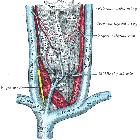Brachiocephalic vein






The brachiocephalic veins, previously known as the innominate veins, are large paired valveless asymmetric veins that drain the head, neck, upper limbs and part of the thorax and mediastinum.
Gross anatomy
Origin
In the root of the neck, the internal jugular (IJV) and subclavian veins unite to form the brachiocephalic veins posterior to the medial ends of the clavicles.
Course
The left brachiocephalic vein is approximately 6 cm long and runs a long, oblique course to the right through the superior mediastinum anterior to the branches of the aortic arch to unite with the right brachiocephalic vein posterior to the first sternocostal joint to form the superior vena cava.
The right brachiocephalic vein is much shorter, approximately 2.5 cm long and runs a vertical course anterior to the brachiocephalic trunk. It becomes the superior vena cava as it is joined from the left by the left brachiocephalic vein.
Tributaries
Right brachiocephalic vein
- right vertebral vein
- inferior thyroid vein
- right internal thoracic vein
- right superior intercostal vein
Left brachiocephalic vein
- left vertebral vein
- inferior thyroid vein
- left internal thoracic vein
- supreme intercostal vein
- thymic veins
- pericardiophrenic veins
Relations
- anteriorly: pleura, upper lobes, thymus, manubrium
- posteriorly: aortic arch (left brachiocephalic vein), great vessels, the dome of the pleura
Variant anatomy
Siehe auch:
und weiter:

 Assoziationen und Differentialdiagnosen zu Left brachiocephalic vein:
Assoziationen und Differentialdiagnosen zu Left brachiocephalic vein: